 Stuff About Genesis
Stuff About Genesis
|
|
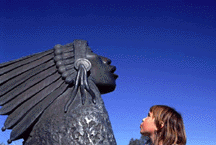 Across
the centuries, young people have looked to the skies
and asked, "What happens
when... we catch a piece of the sun?" Let's
begin at the beginning of the mission--and it all started
with someone just like you! Across
the centuries, young people have looked to the skies
and asked, "What happens
when... we catch a piece of the sun?" Let's
begin at the beginning of the mission--and it all started
with someone just like you! |
|
 Where does a NASA mission begin?
Where does a NASA mission begin? |
|
| NASA's
Genesis mission began years ago in the mind of a young
boy, named Don
Burnett, who looked to the sky and asked, "What
happens when we catch a piece of the sun? Does it have
clues to the solar system? Can it tell us about the
formation of the planets? I wonder." This young boy
is now the head scientist in the Genesis mission. He
is called the principal investigator. He continues to
ask the questions that NASA hopes will be answered by
studying solar wind. A child with
a question can become the reason a NASA mission exists.
|
|
 What
does the sun have in common with American baseball? What
does the sun have in common with American baseball?
|
|
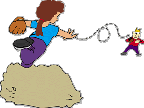 Did
you know that the sun pitches pieces of itself into
the atmosphere around it? These pieces are called solar
wind. They form the basis for the science around NASA's
Genesis mission. Studying pieces of solar wind will
help scientists determine what the sun is actually made
of. We can hope to learn what chemical reactions happen
when stars and planets form. Did
you know that the sun pitches pieces of itself into
the atmosphere around it? These pieces are called solar
wind. They form the basis for the science around NASA's
Genesis mission. Studying pieces of solar wind will
help scientists determine what the sun is actually made
of. We can hope to learn what chemical reactions happen
when stars and planets form. |
|
 What
have we learned about the sun in the last 200 years?
What
have we learned about the sun in the last 200 years? |
|
| 200
years ago, some scientists thought that the sun was
a cooling ball of hot iron. Others thought it was a
gigantic globe of burning coal. Once we gained an understanding
of gravity, some scientists then thought that meteors
were falling into the sun, giving it fuel to burn. |
|
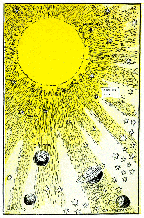 An
Irish gentleman named Lord Kelvin even proposed that
the sun was kept hot by devouring whole planets and
releasing their energy upon impact. This idea brought
more questions about how the sun was fueled. An
Irish gentleman named Lord Kelvin even proposed that
the sun was kept hot by devouring whole planets and
releasing their energy upon impact. This idea brought
more questions about how the sun was fueled. |
|
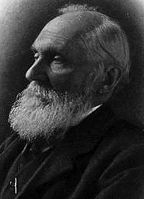  
Among
other things,
Lord
Kelvin invented a tide predictor. |
|
Courtesy
of The Archives,
California Institute of Technology |
|
|
Now this is some serious science stuff! In
the early 1900s, scientists decided that the Earth and
the sun were much older than once thought. At this time,
a German physicist named Wilhelm Conrad Rùntgen discovered
X-rays. That's when things really got cooking. Scientists
figured out that atoms of one type of element could
be transformed into atoms of a different element. Could
a nuclear reaction be the power source of the sun? In
1929, George Gamow, an American physicist who came from
Russia, suggested that four hydrogen nuclei fused together
to form one helium nucleus called hydrogen fusion. Not
many details were known about fusion at this point.
It was not until the 1950's that scientists were certain
that proton-proton fusion was what fueled the sun. Scientists
today study the sun in many ways, one in which is by
studying the Standard Solar
Model. In
the early 1900s, scientists decided that the Earth and
the sun were much older than once thought. At this time,
a German physicist named Wilhelm Conrad Rùntgen discovered
X-rays. That's when things really got cooking. Scientists
figured out that atoms of one type of element could
be transformed into atoms of a different element. Could
a nuclear reaction be the power source of the sun? In
1929, George Gamow, an American physicist who came from
Russia, suggested that four hydrogen nuclei fused together
to form one helium nucleus called hydrogen fusion. Not
many details were known about fusion at this point.
It was not until the 1950's that scientists were certain
that proton-proton fusion was what fueled the sun. Scientists
today study the sun in many ways, one in which is by
studying the Standard Solar
Model.
|
|
| 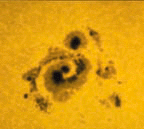 Did
you know that the sun has spots? Did
you know that the sun has spots?
Sunspots
are relatively cool areas that appear as dark blemishes
on the face of the sun. |

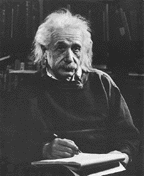
|
|
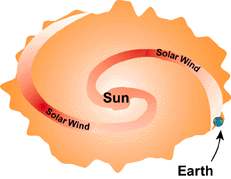
The sun is a huge ball of hot gas. It is glowing brightly
because it is so hot. The gas is made of atoms of hydrogen
and other chemical elements. The sun is so hot that
sometimes pieces are shot out into space. These pieces
are single atoms or parts of atoms. All these pieces
together make up the solar wind. Solar wind flows out
from the sun in all directions.
|
|
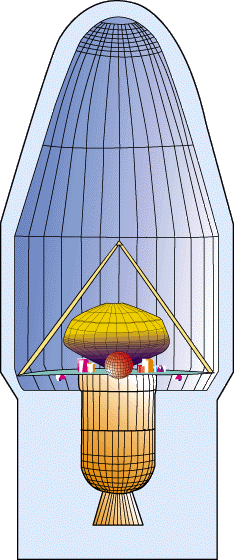
This is the Genesis spacecraft folded and fixed inside
the nosecone of the rocket. We know that the sun is
far away and very hot. NASA scientists want to study
what the sun is made of, and there is only one way to
do it. They need a sample--actual pieces of the sun.
How can they get pieces of the sun back to Earth to
study? How about sending a spacecraft to try to scoop
up part of the sun and bring it back? Nope. 'Won't
work. The temperature of the outside layer of the sun
is about a million degrees. It would melt the spacecraft.
There must be a safer way. It is a better idea to bring
back the small pieces of the sun that are thrown into
space. The spacecraft can stay a safe distance from
the sun. This is what the Genesis mission does. NASA's
Genesis mission launches a folded spacecraft on a rocket,
and the spacecraft flies toward the sun. The Genesis
spacecraft sunbathes for over two years, trapping tiny
pieces of solar wind that hit it. Then it folds itself
up again and returns to Earth. Scientists will study
the pieces of the sun that are trapped inside the spacecraft. |
|
 So
exactly where is the Genesis spacecraft going? So
exactly where is the Genesis spacecraft going? |
|
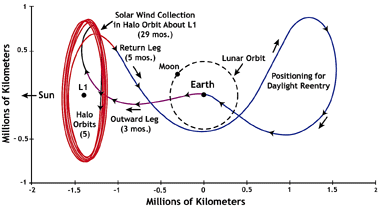 Following
launch aboard a Boeing Delta II rocket, the Genesis
spacecraft will travel to a point in the solar system
called L1. It's a libration point, and these are special
points, located throughout the universe, that can be
used for low fuel trajectories (paths that require less-than-normal
fuel). These points are called libration points. Librate
is a verb that means to swing slightly in opposite directions,
like the needle on a bathroom scale when it is coming
to a rest. An object librates because it is being affected
by two opposing forces. Libration points in space are
places between two orbiting objects where the gravitational
force exerted by the objects on each other is balanced.
The Genesis spacecraft will remain at one of these libration
points and collect solar
wind for two years. As the Earth journeys
around the sun, the location of the sun-Earth libration
points stays constant with respect to those two solar
system objects, but moves from the perspective of a
fictional observer hovering over the Milky Way galaxy
in a spaceship. An object, natural or man-made, which
is at one of the libration points will remain stationary,
as observed from Earth, unless acted on by some additional
force. A satellite can also be made to orbit one of
these points. After its nearly three-year orbit, the
spacecraft will return to the Earth. Following
launch aboard a Boeing Delta II rocket, the Genesis
spacecraft will travel to a point in the solar system
called L1. It's a libration point, and these are special
points, located throughout the universe, that can be
used for low fuel trajectories (paths that require less-than-normal
fuel). These points are called libration points. Librate
is a verb that means to swing slightly in opposite directions,
like the needle on a bathroom scale when it is coming
to a rest. An object librates because it is being affected
by two opposing forces. Libration points in space are
places between two orbiting objects where the gravitational
force exerted by the objects on each other is balanced.
The Genesis spacecraft will remain at one of these libration
points and collect solar
wind for two years. As the Earth journeys
around the sun, the location of the sun-Earth libration
points stays constant with respect to those two solar
system objects, but moves from the perspective of a
fictional observer hovering over the Milky Way galaxy
in a spaceship. An object, natural or man-made, which
is at one of the libration points will remain stationary,
as observed from Earth, unless acted on by some additional
force. A satellite can also be made to orbit one of
these points. After its nearly three-year orbit, the
spacecraft will return to the Earth. |
|
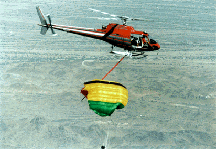
The Genesis sample return capsules will return pieces
of the sun to Earth. The scientists don't
want the sun pieces to get mixed up with anything from
the Earth, so they don't want the returning samples
to touch the Earth. As the capsule parachutes toward
the ground, a helicopter grabs the parachute before
the samples gets too close to the ground. The helicopter
tows the capsule to a very clean storage area. The capsule
is unloaded carefully so the pieces of the sun are kept
clean. |
|
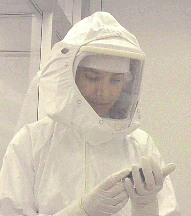
Scientists will slice off thin pieces of the collector
materials. They will do this inside a very clean cabinet.
The pieces of the sun will be separated from the other
material. Then special tools help the scientists identify
the exact chemicals found in the sun. It
will return the collected sample to Earth where the
particles will be archived at Johnson Space Center for
scientists to study with the most modern analytical
tools. The Genesis solar wind samples will be an international
curiosity to be studied by cosmologists attempting to
understand the origin of planetary diversity.The pieces
of the collector materials containing pieces of the
sun will be a national treasure. They will be stored
in a special clean room for other scientists to study. |
|
|
Cool
Stuff About Genesis |
Sunwatchers |
Roping
Rainbows |
-
About
Genesis
-
-
-
|
-
-
-
|
-
-
|
|
